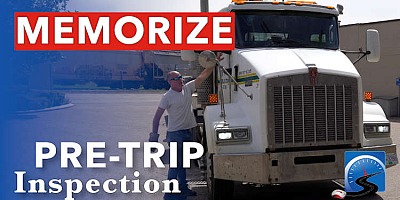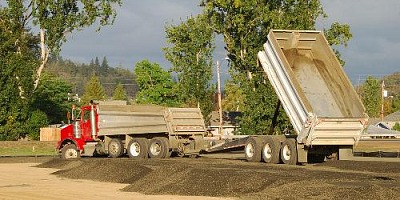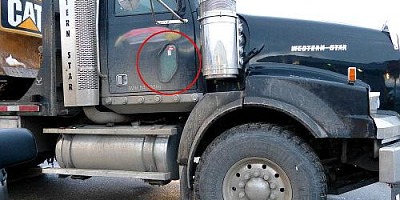For the purposes of the CDL pre-trip inspection, tires are a major component. Learn how to inspect these.
How to Inspect Tires to Pass Your CDL Pre-trip Inspection TEST | CDL Road Test Smart
Introduction
Talking about tires on commercial vehicles, not just trucks, but this applies to buses as well.
In a pre-trip inspection we whack the tires (ie hit the tires with a hammer).
Now there is some discrepancy on this point.
My firm belief is is that the only thing that whacking a tire is going to tell you, is whether this inside dual is flat or not.
Because it's being held up by the tires on the outside.
 City work and local deliveries are going to be harder on tires than long-haul work.
City work and local deliveries are going to be harder on tires than long-haul work.
Some driving instructors and some other people— truck drivers and what not—believe that they can tell the difference of a few pounds of pressure in these tires.
I'm not on board with that at all.
These tires hold a hundred pounds of pressure; that's what the recommended inflation pressure is.
There is some belief in the industry that if they're 10 percent less— so ninety pounds of air, they're under-inflated.
Today we're gonna talk about tires on commercial vehicles and give you some information so that you can stay employed for one thing, and keep your job, keep rolling up and down the road.
We'll be right back with that.
| Don't Fail Your Pre-Trip Inspection Test…Buy the Course! | |
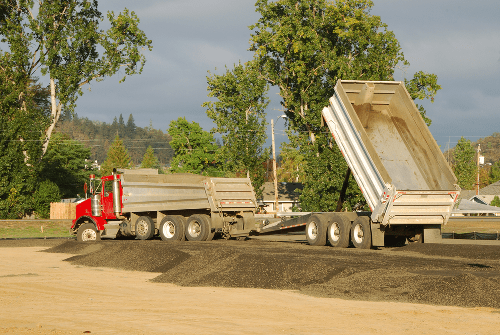
A FAST course for CDL Drivers learning their pre-trip inspection.
This self-paced FAST course gives you:
|
GUARANTEED TO PASS FIRST TIME
Retreads on the rear of Commercial Vehicles
Talking about tires on big trucks.
On the rear of vehicles, these four tires the tandems, & the tires on the rear of the trailer - back there can be retreads.
So what they do is they take the old casing when when the tread wears off, and they take it to a Kal Tire, or one of the other big tire manufacturers‚ Michelin, Goodyear, all those places and they put a new tread on top of the casing.
So this is important for drivers to know because if your're driving around and you get a flat tire you don't want to run around until the casing is wrecked.
 The semi-trailer tires and the tires on the rear of the semi-truck can be re-treads. Steer tires must be new.
The semi-trailer tires and the tires on the rear of the semi-truck can be re-treads. Steer tires must be new.
Because that casing alone is worth about $175.
So it's important to know not to wreck the casing.
Tires Sizes
Now the other thing you need to know about tires on the back of the truck: these are 22.5s - a lot of tires are 24s - those are the two most common sizes so obviously the 24 is bigger.
And why this is important is because:
A) there is a little bit of fuel mileage benefit because the tire doesn't roll as much on a bigger tire.
B) also when you dropped trailers—semi-trailers—off the back of a big truck, it drops the trailer at a different height so it's important when you're hooking up to get out and check the trailer height.
Because if the semi-trailer is too high, you're gonna drop the kingpin over the front of the fifth wheel.
And let me tell you from personal experience it's a bit of a pain in the butt to get that out of there.
 If the semi-trailer is not the correct height to hook to the 5th wheel, you could drop the king pin over the front. And it's really tough to get out.
If the semi-trailer is not the correct height to hook to the 5th wheel, you could drop the king pin over the front. And it's really tough to get out.
And I'll make another video to explain to you—if you do drop the kingpin over the front of the fifth wheel—how to get that out of there.
Gators
So tires on the back of trucks and semi-trailers are retreads.
A lot of people in the industry they're called Gators.
If you get a hunk of retread that comes off and flies on the road, it's called a gator because it takes a bite of your vehicle if you run over it.
It's becoming less and less common that the retreads are flying off these tires.
I mean it still happens once in awhile but the adhesive— the vulcanizing process—that they use to adhere the retread to the casing is getting better and better.
The chemical technology and improvements are getting much better.
So these retreads come apart on a lot less frequent basis.
This is the front steer tire on a truck.
Front steer tires have to be brand new.
They cannot be retreads as they can on the back of the truck and on the semi-trailer - they have to be brand new.
 Inspecting a CDL tire - must have 3mm(1/8"inch) of tread on the steer tires; 1.6mm(1/16" inch) on the rear tire; no gashes longer than 2.5cm(1"inch); and not gashes that expose the tread chord.
Inspecting a CDL tire - must have 3mm(1/8"inch) of tread on the steer tires; 1.6mm(1/16" inch) on the rear tire; no gashes longer than 2.5cm(1"inch); and not gashes that expose the tread chord.
Inspecting a Tire for a Road Test
Now you need to know for the purposes of a road test that tread depth on the front is 3mm (1/8 inch) minimum to pass the road test or to pass and MVI (Motor Vehicle Inspection) that the tread depths.
On the rear tires it can be 1/16 inch or 1.6mm.
The other criteria that a tire has to have to pass a road test - it cannot have any cuts are gashes in the tire that are longer than 2.5cm or one inch, and there cannot be cuts or abrasions in the tire that expose the chord inside the tires.
If any of those criteria exist, the tire won't pass, will not pass a MVI.
You will not pass a road test, and if you show up with tires with those conditions for road test, you won't be able to take the road test.
 Even wear & adequate tread is what you're looking for on the tires. You're also looking for bumps, cracks or gouges.
Even wear & adequate tread is what you're looking for on the tires. You're also looking for bumps, cracks or gouges.
Unsafe Tires
On the top of this tire—this is a front tire—on this truck you begin to see that this tire is beginning—there's a dip here in the tread.
This tread is worn deeper than this tread.
And this side - so this tire has uneven wear - you can see that it's worn more on this side of the tire than it is on this side of the tire.
This front tire on this truck is not safe and needs to be replaced.
Tires on the front of commercial vehicles have to be brand new.
Tire Wear Bars
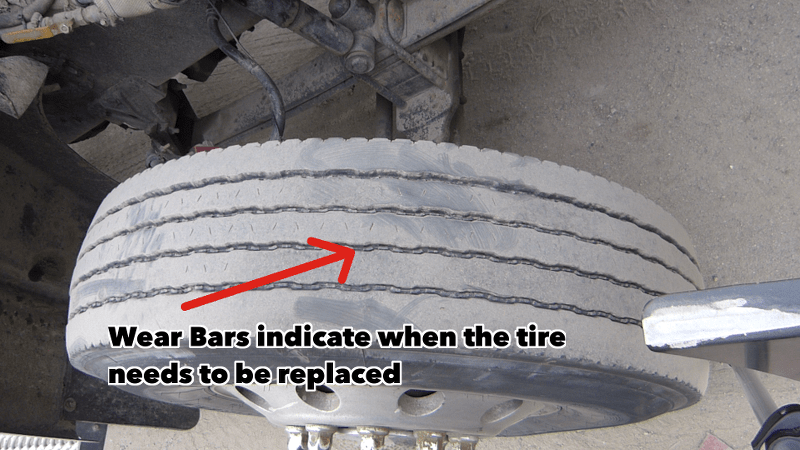 Wear bars between the treads of the tire indicate when the tire is no longer safe and needs to be replaced.After you pass your road test, you don't really need to know the information that is required in terms of 1.6mm on the rear, 3mm on the front, and gashes that are not longer than 2.5cm.
Wear bars between the treads of the tire indicate when the tire is no longer safe and needs to be replaced.After you pass your road test, you don't really need to know the information that is required in terms of 1.6mm on the rear, 3mm on the front, and gashes that are not longer than 2.5cm.
What you do need to know is inside the tread are wear bars.
And you can see the wear bars here.
If the tire tread is down to wear bars on the steer tires on the front, the tire needs to be replaced.
Now as I said, steer tires on the front of the trucks—commercial vehicles, buses those types of things—have to be new tires.
A new steer tire on the front of a commercial vehicle is $600 to a $1000, depending on the type of tire.
This tire is not a very expensive tire, thus it's abnormally worn on the front and will soon need to be replaced.
So you either spend a little bit more and get a better quality tire and it'll last longer.
Now the reason, because a front steer tire is $600—$1,000 - the reason they put recaps on the rears and on the trailers is because a recap will cost you about $375—$400.
There's considerable saving in getting recaps for the rear of semi trucks and the trailers.
They're also allowed on the rear of buses, but not on the steer axles.
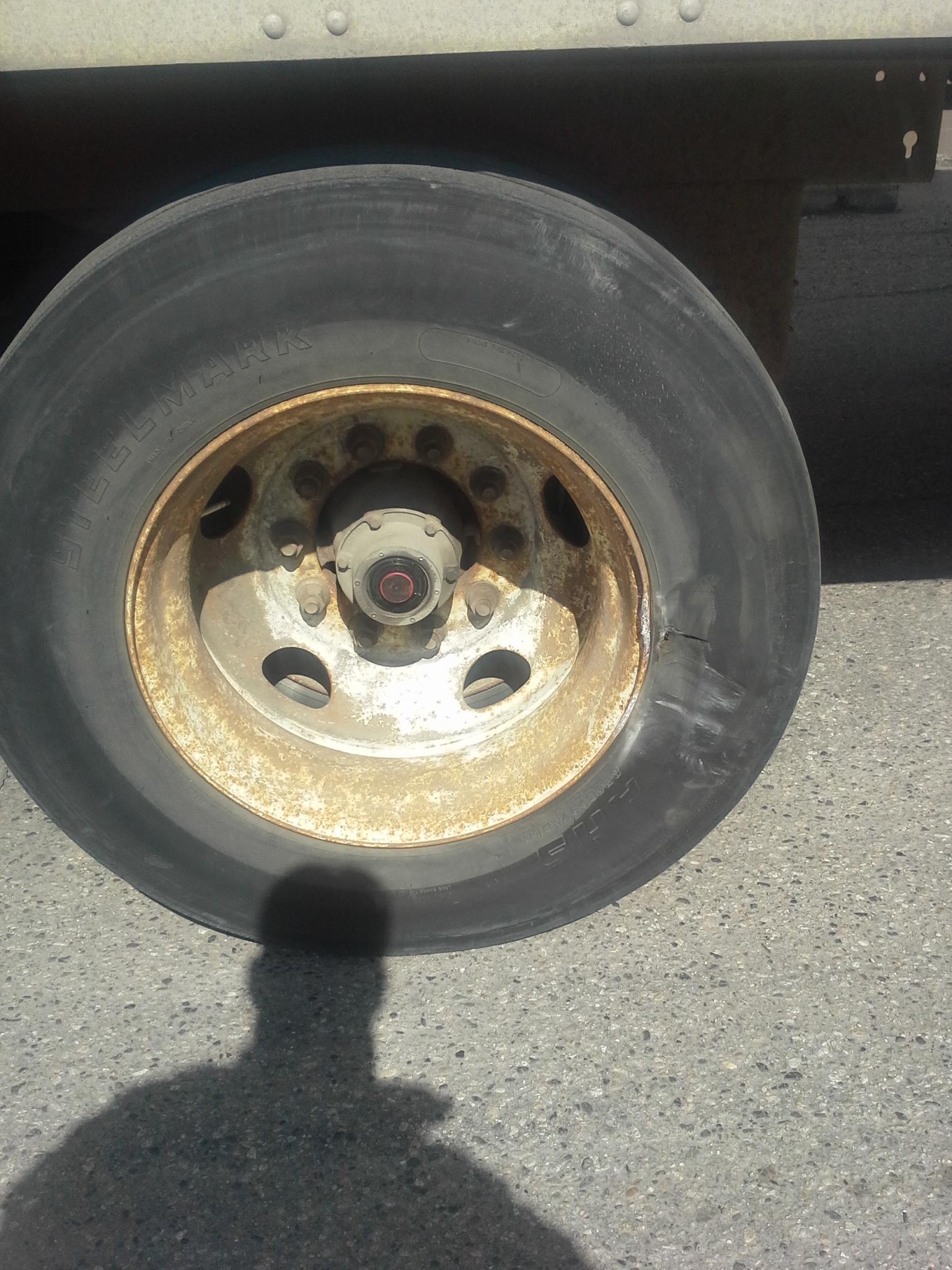 A damaged semi-trailer tire where the driver struck a concrete barrier. The concrete barrier bent the semi-trailer tire rim.
A damaged semi-trailer tire where the driver struck a concrete barrier. The concrete barrier bent the semi-trailer tire rim.
They have to be brand new.
That's a little bit of information about tires on commercial vehicles.
Conclusion
In conclusion, tires on commercial vehicles - on the front they're brand new tires.
They have wear bars on them.
You can tell that the tires worn because it'll be down to wear bars on the steer tires.
On the rear of the truck or bus or semi-trailer, they can be recaps.
A recap is about $375; a brand-new steer tire is $600—$1,000 depending on the quality of the tire.
Recaps are about $375—$450 - considerable savings on recaps.
The vulcanizing process to put the tread on the old casing is getting much better, so it's unlikely that you're gonna see Gators on the road - pieces a retread.
They take a bite out of your vehicle & they're called Gators.
 Check the tires on your vehicle during your pre-trip inspection and your enroute inspections to ensure you're not driving around with a flat tire.
Check the tires on your vehicle during your pre-trip inspection and your enroute inspections to ensure you're not driving around with a flat tire.
Hitting a tire with a hammer, in my professional opinion, only tells you the inside of the tire is flat.
The only way that you're gonna be able to tell if that tire is full pressure—hundred pounds per square inch—is if you put a tire gauge on the tire and have it pumped up.
NOTE: If a tire is low pressure and you see this on trailers a lot.
They get dragged around and they got low tire pressure - you'll see a wave in the chords because the chords let go inside the tire and it's an indicator that the tire needs to be replaced because it's no longer safe and no longer will pass a MVI (Motor Vehicle Inspection).
If you get pulled into a scale they're probably gonna put you out of service because the tire isn't up to standard.
For the purposes of a road test:
(1.6 mm or 1/16") one point six millimeters on the rear tires; (3mm or 1/8") three millimeters on the front; any gouges longer than (2.5cm or 1") 2.5 centimeters.
And any cuts or abrasions in the top of the tires that expose the chords.



